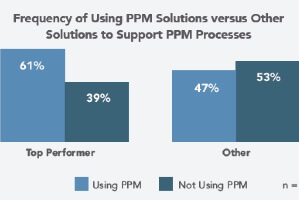 How can companies manage their portfolios and product development processes in order to more reliably hit their product innovation and commercialization challenges? How does digital transformation raise the bar on product portfolio management? Tech-Clarity was commissioned by Planview, Inc. to conduct their Sixth Product Portfolio Management Benchmark Study to find out. The research uncovered five best practices that Top Performers follow more frequently than others, resulting in their higher performance in revenue growth, profit margin expansion, and percent of sales from new products than their competitors. The survey also took a hard look at how digitalization impacts product planning and development, and finds that the transition to smarter, more connected products makes current PPM challenges worse.
How can companies manage their portfolios and product development processes in order to more reliably hit their product innovation and commercialization challenges? How does digital transformation raise the bar on product portfolio management? Tech-Clarity was commissioned by Planview, Inc. to conduct their Sixth Product Portfolio Management Benchmark Study to find out. The research uncovered five best practices that Top Performers follow more frequently than others, resulting in their higher performance in revenue growth, profit margin expansion, and percent of sales from new products than their competitors. The survey also took a hard look at how digitalization impacts product planning and development, and finds that the transition to smarter, more connected products makes current PPM challenges worse.
Please enjoy a summary of the Executive Brief, including a list of the five best practices, below.
For the full report, please visit our sponsor Planview (no charge, registration required).
Analyzing Product Innovation Performance
This Sixth Product Portfolio Management Benchmark Study surveying more than 400 industry practitioners finds that companies continue to struggle to meet product innovation and commercialization targets. Survey respondents indicate they hit product launch dates just 54% of the time, on average, and meet revenue targets only 55% of the time. New results from the ongoing product development benchmarking research commissioned by Planview show that companies continue to grapple with some of the same challenges they have for the last decade, including having too many projects for their resources. Despite proven best practices for developing successful, pr products, many companies continue to suffer the pitfalls of poor Product Portfolio Management practices.
Digital Transformation Raises the Bar on Product Innovation and the Product Portfolio Management Discipline
Now is the time to address Product Portfolio Management process and performance gaps. New survey questions gauging how the transition to smarter, more connected products and the digital enterprise impacts product innovation indicate that current challenges are about to get worse. This is critical given the major digital transformation facing the manufacturing industry. According to McKinsey’s Why Digital Strategies Fail, only 8% of companies said their current business model would remain economically viable if their industry keeps digitizing at its current course and speed. Manufacturers that don’t successfully digitalize, even the largest companies, stand the risk of losing market share, and they are responding accordingly about 13% are currently delivering smarter, more connected products, another 44% are either actively developing or actively researching them. A further 27% are considering adding them. This is having a significant, direct impact on product – and Product Portfolio Management – complexity.
The Best Practices
 In summary, the best practices identified by the benchmarks research show that Top Performers are more likely to:
In summary, the best practices identified by the benchmarks research show that Top Performers are more likely to:
- Have access to more accurate, timely portfolio data to make decisions
- Follow portfolio processes more consistently
- Reallocate people and money to higher value innovations
- Have better portfolio and capacity management and planning
- Use PPM technology to enable these best practices
NOTE: For the full detail on best practices, please download the Executive Brief.
Conclusion
Companies continue to miss their product development targets, most notably time to market and related product revenue goals. Too many still fall victim to common Product Portfolio Management challenges, despite the availability of proven best practice processes and technology. Analyzing the Top Performers provides a roadmap that can help other companies overcome challenges and achieve higher levels of innovation and product profitability. Others can learn by example, recognizing that leading companies have better data, follow more consistent processes, are able to reallocate people and money to higher value innovations, and have better control of resource capacity – enabling all of this with the use of PPM software. The time to improve Product Portfolio Management performance is here. As the benchmark study shows, the move toward smarter, more connected products and digitalization will significantly increase product and product development complexity. Product Portfolio Management best practices can improve development of current products and prepare companies for the heightened challenges of digital transformation. PPM technology is positioned to address real challenges and improve value today and throughout the digital transformation.
*This summary is an abbreviated version of the Executive Brief and does not contain the full content. A link to download the full research is available above.
If you have difficulty obtaining a copy of the report, please contact us using the “Contact” link below.

